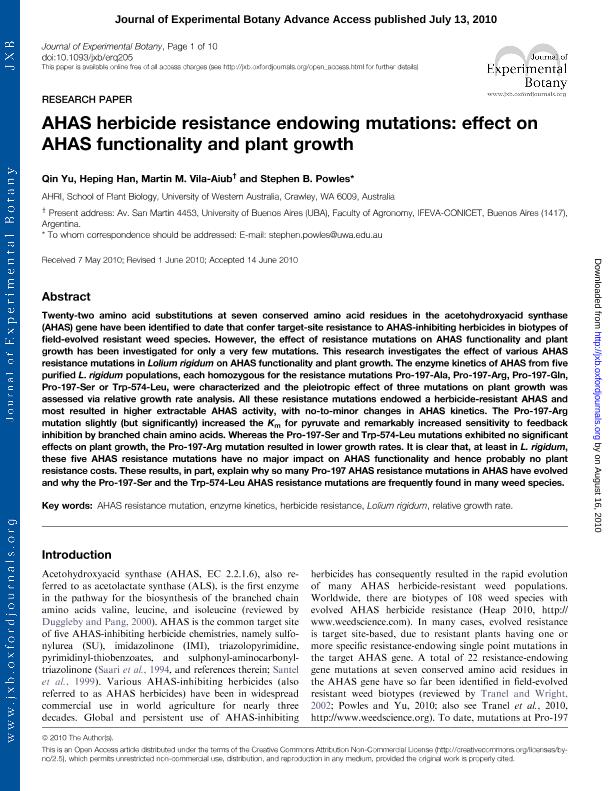Mostrar el registro sencillo del ítem
dc.contributor.author
Yu, Qin
dc.contributor.author
Han, Heping
dc.contributor.author
Vila Aiub, Martin Miguel

dc.contributor.author
Powles, Stephen B.

dc.date.available
2019-03-11T18:12:48Z
dc.date.issued
2010-09
dc.identifier.citation
Yu, Qin; Han, Heping; Vila Aiub, Martin Miguel; Powles, Stephen B.; AHAS herbicide resistance endowing mutations: Effect on AHAS functionality and plant growth; Oxford University Press; Journal of Experimental Botany; 61; 14; 9-2010; 3925-3934
dc.identifier.issn
0022-0957
dc.identifier.uri
http://hdl.handle.net/11336/71353
dc.description.abstract
Twenty-two amino acid substitutions at seven conserved amino acid residues in the acetohydroxyacid synthase (AHAS) gene have been identified to date that confer target-site resistance to AHAS-inhibiting herbicides in biotypes of field-evolved resistant weed species. However, the effect of resistance mutations on AHAS functionality and plant growth has been investigated for only a very few mutations. This research investigates the effect of various AHAS resistance mutations in Lolium rigidum on AHAS functionality and plant growth. The enzyme kinetics of AHAS from five purified L. rigidum populations, each homozygous for the resistance mutations Pro-197-Ala, Pro-197-Arg, Pro-197-Gln, Pro-197-Ser or Trp-574-Leu, were characterized and the pleiotropic effect of three mutations on plant growth was assessed via relative growth rate analysis. All these resistance mutations endowed a herbicide-resistant AHAS and most resulted in higher extractable AHAS activity, with no-to-minor changes in AHAS kinetics. The Pro-197-Arg mutation slightly (but significantly) increased the Km for pyruvate and remarkably increased sensitivity to feedback inhibition by branched chain amino acids. Whereas the Pro-197-Ser and Trp-574-Leu mutations exhibited no significant effects on plant growth, the Pro-197-Arg mutation resulted in lower growth rates. It is clear that, at least in L. rigidum, these five AHAS resistance mutations have no major impact on AHAS functionality and hence probably no plant resistance costs. These results, in part, explain why so many Pro-197 AHAS resistance mutations in AHAS have evolved and why the Pro-197-Ser and the Trp-574-Leu AHAS resistance mutations are frequently found in many weed species.
dc.format
application/pdf
dc.language.iso
eng
dc.publisher
Oxford University Press

dc.rights
info:eu-repo/semantics/openAccess
dc.rights.uri
https://creativecommons.org/licenses/by-nc-sa/2.5/ar/
dc.subject
Ahas Resistance Mutation
dc.subject
Enzyme Kinetics
dc.subject
Herbicide Resistance
dc.subject
Lolium Rigidum
dc.subject
Relative Growth Rate
dc.subject.classification
Otras Ciencias Biológicas

dc.subject.classification
Ciencias Biológicas

dc.subject.classification
CIENCIAS NATURALES Y EXACTAS

dc.title
AHAS herbicide resistance endowing mutations: Effect on AHAS functionality and plant growth
dc.type
info:eu-repo/semantics/article
dc.type
info:ar-repo/semantics/artículo
dc.type
info:eu-repo/semantics/publishedVersion
dc.date.updated
2019-03-08T20:20:16Z
dc.journal.volume
61
dc.journal.number
14
dc.journal.pagination
3925-3934
dc.journal.pais
Reino Unido

dc.journal.ciudad
Oxford
dc.description.fil
Fil: Yu, Qin. University of Western Australia; Australia
dc.description.fil
Fil: Han, Heping. University of Western Australia; Australia
dc.description.fil
Fil: Vila Aiub, Martin Miguel. University of Western Australia; Australia. Consejo Nacional de Investigaciones Científicas y Técnicas. Oficina de Coordinación Administrativa Parque Centenario. Instituto de Investigaciones Fisiológicas y Ecológicas Vinculadas a la Agricultura. Universidad de Buenos Aires. Facultad de Agronomía; Argentina
dc.description.fil
Fil: Powles, Stephen B.. University of Western Australia; Australia
dc.journal.title
Journal of Experimental Botany

dc.relation.alternativeid
info:eu-repo/semantics/altIdentifier/doi/http://dx.doi.org/10.1093/jxb/erq205
dc.relation.alternativeid
info:eu-repo/semantics/altIdentifier/url/https://academic.oup.com/jxb/article/61/14/3925/522854
Archivos asociados
